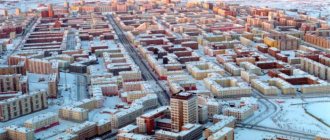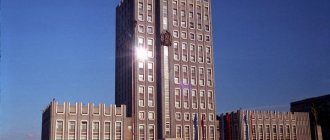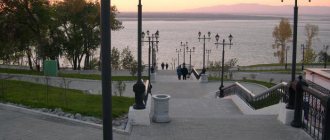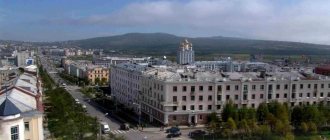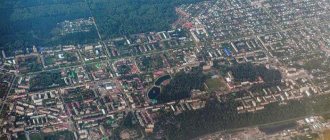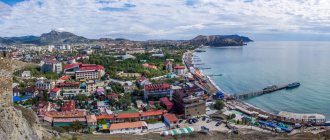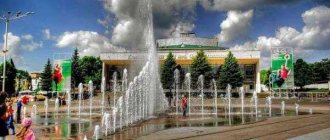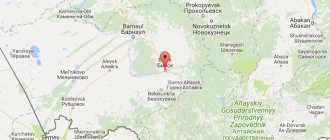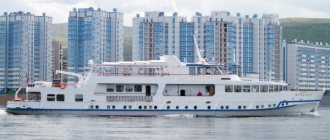You can often hear about a city like Norilsk. And it is not surprising, since this is a large settlement that deserves special attention. It occupies a fairly large area and is home to many production and industrial facilities. It is worth getting to know this wonderful city better. Norilsk, which has a small population, has many interesting sights. The article will also talk about climate, nature, and interesting facts related to this locality.
Norilsk: general information about the city
The city is located in the Krasnoyarsk Territory and is the administrative center of the district. Interestingly, it ranks second in terms of the number of people living on its territory (Krasnoyarsk is in first place).
The city is located in a rather harsh climatic zone. Norilsk received the status of the northernmost city, home to a population of more than 150 thousand people.
However, his records don't end there. The city of Norilsk is among the settlements with the worst environmental conditions. This happened due to the fact that the main activities of the city are mining and metal production. This area has become a leader because there are no industrial zones of this scale anywhere else in the world.
Another interesting fact is that entry into the city is closed to foreign citizens. To visit Norilsk, foreign tourists must undergo the procedure of obtaining a special permit. Such measures have been in force since 2001. Before this, since 1991, foreign citizens could freely visit Norilsk.
Norilsk churches
As you know, there were many clergymen among the Gulag prisoners. They, secretly from the camp administration, confessed and gave communion to prisoners seeking to find peace in faith. However, there was no talk of official services then. Accordingly, there were no religious buildings in the city. The situation changed radically at the turn of the century. Already in modern times, temples of the main religious denominations appeared here.
Cathedral in the name of the icon “Joy of All Who Sorrow”
- Opening hours: daily, from 8:00 to 20:00.
- Telephone.
- Website: https://norilsk-eparhia.cerkov.ru
- Address: st. Pushkina, 11. Transport stop "Temple".
The first service under the arches of the main city church, consecrated in the name of the revered Orthodox relic, took place in 1997. However, it took another 6 years to complete the construction of the cathedral. But this time was not wasted. The church is truly impressive. The heavenly blue of its starry domes is set off by the blackened roof of the tent under the main gilded onion. The turquoise color of the facade is in harmony with the whiteness of the arches and columns. The cathedral exudes lightness, calm, and peace. By the way, the place for the construction of the temple was not chosen by chance. The cathedral was erected over the ruins of the barracks of Norillag, which crushed tens of thousands of human destinies.
Trinity Church
- Opening hours: daily, from 7:00 to 19:00.
- Telephone.
- Website: https://talnah-hram.cerkov.ru
- Address: st. Stroiteley, 13A. Transport stop "Shopping Center".
Half an hour’s drive from Norilsk is the village of Talnakh, where it’s worth a trip just to admire the amazing temple. The elegant building seems to be a revived illustration for books on the ancient history of Rus'. This is exactly what the churches of the distant ancestors of today's Russians, who lived in the Middle Ages near Smolensk , Tver or Pskov . The temple is colorful not only from the outside. Under its roof one can feel an atmosphere of special splendor created by the harmonious combination of discreet surroundings, the natural warmth of wood, which prevails in the decoration of walls and vaults with the solemnity of the images of the iconostasis.
Noord-Kamal Mosque
- Opening hours: daily, from 8:00 to 22:00.
- Telephone.
- Address: st. 50 years of October, 2. Transport stop “School No. 1”.
The only Muslim temple in the city, which opened its doors to believers in the fall of 1988, has every reason to be considered an iconic landmark of Norilsk. Firstly, it is the northernmost mosque ever built on the planet. The validity of this statement is confirmed by the corresponding entry in the Guinness Book of Records. Secondly, Nurd-Kamal’s appearance is somewhat different from the standards of Islamic religious architecture. The minaret of the temple, rising 30 meters above the ground, has the shape of a tetrahedral obelisk, rather than the classic round tower. The unconventional configuration makes the structure more resistant to strong winds and dense snowstorms - a common phenomenon for Norilsk in winter.
What areas are included in the city?
Previously, Norilsk was not such a large settlement. After the annexation of neighboring cities, it became much larger. Norilsk consists of several districts:
- Central.
- Talnakh.
- Kayerkan.
- Snezhnogorsk
- Oganer.
They are all noticeably different from each other. Some districts, for example Central, were built earlier; Leningrad architects were invited to design them. Others date back to a later period. They are mainly built up with houses built according to standard designs.
The main attractions of Norilsk: TOP-5
What should you see first in Norilsk? Of course, to architectural, historical and miraculous objects that claim to be the calling cards of the capital of the Russian Arctic!
Gvardeyskaya Square
- Address: historical center of Norilsk. Transport stop "Yenisei Store" or "Talnakh Department Store".
The rating of Norilsk sights opens with the main square of the city - the majestic creation of Soviet architects, who brilliantly implemented the project of architects L. Minenko and V. Nepokoichitsky. The urban planning ensemble, which was finally formed in the late 60s of the 20th century, looks solemn. The recreation, which has a diameter of 90 m, is framed by semicircular six-story buildings with luxurious arcades and colonnades. Between these buildings, separated by passages, is the mansion of the NMMC Administration. Particularly impressive is the harmony of the architectural composition, in which there is nothing superfluous.
First house
- Address: Leninsky Prospekt, 14. Transport stop "Restaurant Lama".
The inclusion of a nondescript wooden house in the TOP attractions of Norilsk will seem random only at first glance. In fact, every log of this mansion is imbued with symbolism. Still would! It is the only one of the first buildings erected on the territory of the subarctic city that has survived to this day. It was under the roof of a plank hut that the participants of N. Urvantsev’s expedition spent the winter, which discovered a rich deposit of coal and minerals containing sulfides in the vicinity of Mount Rudnaya. The buildings of the hostel, warehouses, and bathhouses were eventually demolished, but the house remained. Now it has been turned into a museum.
Calvary
- Address: Mount Schmidt. Transport stop "Torgmontazh".
The history of Norilsk is not only a series of high-profile labor victories and heroic achievements. There is also an extremely dark page in it. A huge number of prisoners of the notorious Gulag unit, through which almost 500 thousand people passed through during the years of Stalin’s terror, were involved in the construction of the plant and the first city blocks. Many of the prisoners were no longer destined to return home from the harsh Arctic. The memorial complex “Norilsk Golgotha” was erected in memory of the victims of repression who served time in Noril’LAG and died from disease, malnutrition, exhausting labor in inhumane conditions, and the arbitrariness of guards. The composition consists of several objects, the appearance of which clearly reveals features inherent in several architectural schools at once. This was originally intended, because the Gulag crushed human lives, regardless of the nationality of the prisoners. This is a monument to all the victims of the Yezhov-Beri Baal - Russians, Poles, Latvians, Ukrainians, Jews, Estonians.
Norilsk Mining and Metallurgical Combine
- Address: st. Nansen, 5. Transport stop “Zub-mountain”.
The city-forming enterprise is the basic structure of the Norilsk Nickel holding, and is rightfully considered the flagship of the Russian non-ferrous metallurgy. NGM leads the ranking of world producers of palladium and nickel, and is one of the Big Five enterprises supplying the global market with platinum and rhodium. The industrial giant, built by Gulag prisoners and volunteers of the labor army of the Soviet Union, provides work for almost half of the townspeople. The enterprise is included in the register of sensitive facilities, so it is not easy to get a tour of the plant’s workshops. Adherents of industrial tourism should contact the company’s press service on this issue, located in building No. 2 on Gvardeyskaya Square.
Putorana Nature Reserve
- Office hours: daily, from 9:00 to 18:00.
- Telephone.
- Website: https://platoputorana.ru
- Address: st. Talnakhskaya, 22. Transport stop “Anisimova Street”.
The unique natural recreation is the main non-man-made attraction of Norilsk, recognized by UNESCO as part of the World Natural Heritage of Humanity. The vast territory of the reserve covers almost 1900 hectares of taiga, forest-tundra, desert-arctic areas located in the North-West of the Central Siberian Plateau. There are a lot of picturesque ancient lakes of tectonic origin and amazing waterfalls in the conservation area. The height of the peaks of the mountain plateaus in some places reaches 1500 m. The nature here is pristine, and the ecosystems are almost pristine. This is a real Mecca for lovers of extreme travel. The administration of the reserve invites tourists to take part in hiking, water, and ski trips of varying difficulty levels. You will be left with many vivid impressions from an exotic safari.
Norilsk: population and its characteristics
Now it’s worth taking a closer look at the issue concerning the city’s residents. To begin with, it should be noted that a strong increase in the population of Norilsk occurred after 2 more settlements were annexed to it, which bear the names Talnakh and Kayerkan. Currently they are districts of the city. In this regard, the population of Norilsk has increased significantly.
According to 2015 data, the number of local residents is 176,251 people. Recently, there has been a tendency for many people to leave Norilsk. The population has decreased greatly. A particularly serious decline was noticed in 2014. In the previous year, 2013, the number of residents was 177,738 people, in 2014 – already 176,559. In 2015, the decline in numbers continued.
If we look at the ranking of Russian cities by number of inhabitants, Norilsk ranks 105th, which is a fairly high figure. In total, there are about 1114 cities on the list. So, we have become familiar with the data on the city’s population in detail, and now it’s worth moving on to considering its national composition.
Climatic conditions of Norilsk
The city is located within the Far North and is distinguished by the severity of its subarctic climate.
The cold and long winter period with January temperatures of -40 degrees is aggravated by very strong winds.
For example, the December 1978 temperature of -47 degrees was accompanied by wind gusts of up to 27 m/s. The temperature of the air sensation was then minus 101 degrees. This refers to how a person feels temperature when simultaneously exposed to frost and wind of a certain strength. This temperature sensation is very important for Norilsk, because the combination of severe frosts and strong winds is quite common here.
The period of severe cold lasts about 280 days, from mid-September to early May, of which 130 days are accompanied by snowstorms.
The average January temperature is -39.7 degrees. In January 1967, the city recorded a minimum temperature of -53.1 degrees. Snow cover can last from 244 to 277 days.
The city is characterized by a long heating season, lasting 302 days. The polar night lasts for 45 days, which begins on November 30 and lasts until January 13.
The summer period begins at the end of June and lasts until the end of August. Summers are usually cloudy and cool, with July temperatures averaging +13.6 degrees. But there are also very hot days, so the recorded maximum temperature was +32 degrees.
The average temperature for the year is -9.6 degrees. On average, the frost-free period lasts 84 days, and sometimes its duration is reduced to 53 days.
The polar day is celebrated in Norilsk for 67 days, which begins on May 20 and lasts until July 25. Compared to Murmansk, in Norilsk the polar day and polar night come two days earlier and end three days later.
The city is on the list of the five windiest cities in the world, along with Dudinka and the Antarctic Vostok station. The average wind speed throughout the year is 6 m/s.
Relative humidity is 76%.
In Norilsk, about 400 mm of precipitation falls annually, most of it in July-October, but since evaporation is low, there will be excess moisture.
The coldest months are November, December, January and February, during which thaws are completely excluded, the average negative temperature is recorded 8 months a year and only 4 months from May to August have an average positive air temperature.
According to the average daily air temperature, the coldest day of the year is January 14, and the warmest day is July 26.
Note 3
The climatic conditions of Norilsk test the strength of the human body, regardless of his age. In such harsh conditions, depletion of adaptive capabilities and early aging occur. Respiratory and digestive diseases are widespread among young Norilsk residents, and the city ranks 4th in Russia in terms of the number of blood and kidney diseases.
National composition of the population
It is necessary to analyze in detail who lives in this region. The city of Norilsk boasts a rich national composition. Since ancient times, several indigenous peoples have lived here, among whom were the Nenets, Nganasans, Dolgans, and Enets. Nowadays they can be found here quite rarely. As for the permanent population, now Norilsk is mainly dominated by Russians, Ukrainians, Azerbaijanis and other peoples. There are practically no indigenous people left here. The city is mostly inhabited by people who moved here in the middle and end of the 20th century, as well as their descendants.
A noticeable influx of population into this city was due to the widespread development of industry and other local enterprises. A large number of jobs were created here, as well as infrastructure that made life in this place more comfortable.
Features of living in the city
Separately, it is worth paying attention to the characteristic features of local life, of which there are quite a few. These features were formed over a long period, taking into account the climatic, weather and geographical conditions in which Norilsk is located. The population of the city has a special attitude towards preparing food and eating it. There are a large number of fishermen and hunters among the city residents. Thanks to this, shish kebab and sugudai are common dishes. The second one is worth talking about in a little more detail. Sugudai is a snack consisting of raw fish, to which vegetable oil, salt, pepper, onion, grated apple, vinegar and various spices are added. As for other popular products, residents of the city often pick mushrooms, blueberries, lingonberries and cloudberries.
Prices in Norilsk are at an average level, but for some seemingly ordinary products they are too high here. For example, bread can be bought for 60 rubles, a kilogram of chicken meat - for 132 rubles, a kilogram of rice - for 70 rubles, vegetable oil costs 89 rubles. Prices for buckwheat in Norilsk start at 160 rubles, apples are priced at 109 rubles, potatoes cost 53 rubles, and onions – 70 rubles.
It is believed that Norilsk belongs to the Taimyr Peninsula. This region can be reached by two modes of transport: water or air. There is no land connection with the rest of Russia (the so-called mainland).
Geographical location and history of Norilsk
Norilsk is located in the north of the Krasnoyarsk Territory and is the administrative center of the district.
After Krasnoyarsk, the city ranks second in population, despite the fact that it is located in a harsh climatic zone and has the status of the northernmost city.
Figure 1. Norilsk. Author24 - online exchange of student work
Note 1
The city is closed to foreign tourists; they need special permission to enter it. Similar measures were taken in 2001, although from 1991 until this date Norilsk was open to the public.
Are you an expert in this subject area? We invite you to become the author of the Directory Working Conditions
The city territory includes several districts - Central District, Talnakh, Kayerkan, Oganer, Snezhnogorsk, which differ from each other.
The Central District was built first, others later.
The city received its name based on its geographical location - along the nearby Norilka River, and it itself is located near the Norilsk Mountains.
Note 2
The region is a zone of continuous distribution of permafrost rocks, the thickness of which is 40-80 m. This is one of the coldest cities in the world. It is much colder than Murmansk, despite the fact that it is located almost at the same latitude.
Norilsk is located 300 km north of the Arctic Circle, 2,400 km from the North Pole, and 1,500 km from the capital of the Krasnoyarsk Territory.
The geographical location of the city is inconvenient and leads to various problems, one of which is transport accessibility.
There is no land connection with other cities, with the exception of the port of Dudinka.
Finished works on a similar topic
Course work Climatic conditions of Norilsk 460 ₽ Abstract Climatic conditions of Norilsk 230 ₽ Test paper Climatic conditions of Norilsk 210 ₽
Receive completed work or specialist advice on your educational project Find out the cost
Passenger and cargo traffic, if navigation along the Yenisei is closed, is transported by plane from Alykel airport.
The second very acute problem is the high pollution of the atmosphere, into which enterprises annually emit large amounts of sulfur dioxide, phenols, and heavy metal particles.
Norilsk is on the list of the dirtiest cities on the planet. For air poisoning in Canada, Norilsk enterprises pay compensation to her.
The first expedition to this area was made by a group of geologists led by N. Urvantsev in 1920 to study the deposits of the territory.
During the second expedition, in 1921, the first wooden house was built at the foot of the mountain, and already in 1939 Norilsk became a workers' village.
It received city status in 1953. The city was built by political prisoners of the Gulag system, most of whom remained here, considering the city their second homeland.
By this time, the following were built in the city:
- hospitals,
- schools,
- clubs,
- cinema,
- stadium.
City climate
Natural and weather conditions in Norilsk are quite harsh. The city is located in the Far North, and therefore the local climate will be very harsh for a person not accustomed to it. The weather in Norilsk is usually cold. The climate here is subarctic.
The city is considered one of the coldest in the world. So, many people are interested in what kind of weather happens most often in Norilsk? Winter here lasts a long time and is characterized by severe cold. In January the average temperature is about -28 ⁰C. Typical winter weather is frequent frosts with strong winds. The cold period here lasts about 280 days, it begins in mid-September and lasts until the beginning of May.
Summer begins only at the end of June and lasts until the end of August. It is usually cloudy and cool. The average temperature in July is about +10.7 C. If we talk about the average annual temperature, it is -9.6 C.
Another interesting fact is that Norilsk is included in the list of the five windiest settlements in the world.
We went to Norilsk this weekend (56 photos)
Norilsk is a city in the north of the Krasnoyarsk Territory, located in the southern part of the Taimyr Peninsula, approximately 90 km east of the Yenisei. One of the most environmentally polluted cities in the world. The environmental danger for the population of the city and adjacent areas is due to the fact that the city is a “derivative” of one of the world’s largest mining and, at the same time, metal-producing plants (the so-called city-forming complex). There are no analogues of the Norilsk industrial area (including the city) anywhere else in the world.
It is located above the Arctic Circle and is one of the northernmost cities in the world, geographically located in the Taimyr (Dolgano-Nenets) region of the Krasnoyarsk Territory, administratively a city of regional subordination. In 2004, two satellite cities (Talnakh, Kayerkan), as well as the village of Snezhnogorsk, were annexed to the city of Norilsk.
The climate of the city is subarctic. Winter is very long and cold, summer is short. The warmest months are July and August.
Average annual temperature: ?11 °C Average January temperature: ?36 °C Average July temperature: +13.6 °C Minimum recorded temperature: ?61 °C Maximum recorded temperature: +32 °C Average duration of frost-free period: 84 days Number of days with precipitation: 170 Number of days with snowstorms: 130 Average duration of snow cover: 244 days (from 7.5 to 9 months)
Change of day and night: from November 30 to January 13: polar night (45 days), from January 13 to March 27: normal day and night change (73 days), from March 27 to April 26: twilight nights (30 days), from April 27 to May 19: white nights (23 days), from May 19 to July 25: polar day (68 days), from July 25 to August 15: white nights (23 days), from August 15 to September 15: twilight nights (30 days), from September 15 to November 30: normal day and night cycle (73 days).
To assess the weather in the far north, not only air temperature, but also wind strength is often used. For this purpose, “Weather Hardness” is calculated - the temperature equivalent of a person’s sensations when simultaneously exposed to frost and wind of a certain strength.
The conditional scheme for assessing the severity of weather is as follows: every meter per second of wind is equivalent to two degrees of frost if the temperature drops below? 40 °C. Determining the severity of weather is relevant for Norilsk, since frosts are often combined here with strong winds (in December 1976, at a temperature of -47 °C, wind gusts of up to 25 m/s were recorded).
This is how the terminal leading us to board the Moscow-Norilsk flight at Domodedovo Airport saw us off before departure.
And after 4.5 hours of flight, we were met by Alykel airport.. On an early frosty morning and with a temperature of -46 degrees.. The local guys who met us at the airport even managed to relieve themselves behind a snowdrift :))))
There is not a single road leading to Norilsk, not a single train runs, so you can get here only in two ways - by plane or by ship.
The airport operates according to actual weather conditions. This means that the weather changes so quickly that it is monitored hourly. This is especially true for wind. Now it could be 3-5 m/s, and in an hour 15 with gusts up to 20-25. Due to storms, flights can be delayed for up to a week. The airport is located in the satellite town of Kayerkan, which is translated from the indigenous language as “Death Valley”.
The road from the airport to Norilsk is about 50 kilometers, passes along the abandoned village of Alykel, where all that remains from all its former life are empty abandoned nine-story panel buildings, past Kayerkan itself and the metallurgical plant with the ironic name “Nadezhda”.
The closer we got to the city, the more we plunged into heavy fog, which was an unusual phenomenon for me in such frosty weather. In the city itself, visibility was about several tens of meters.
Having checked into the hotel and rested for a couple of hours, we went on our first walk through this harsh city at -42.. The temperature drop was more than 70 degrees..
Most of the houses in the city are built on stilts driven into perpetual soil, since it is impossible to build a foundation there.
And towards evening, we made another foray into the city at night. The frost became stronger, and visibility dropped even more due to the fog.
Polar bears dutifully guard their city:
This is how our first day in Norilsk went. Arriving at the hotel room, we were stunned by the heat and opened the windows.. It was about +30 degrees in the room, while it was -42 outside. Due to the very dry air in the hotel, everything emitted static electricity, and I want to say, very strongly, with a bang. Once again I didn’t want to touch anything like the TV or batteries)))
The morning of the next day was also foggy, but a light wind that rose outside was still able to disperse the haze a little and open access to the sun.
Norilsk Polar Drama Theater:
And we even went down the hill in the city center:
Behind us is the building of Norilsk Telecom, a local Internet provider. Internet prices here are the highest, which is easily explained: all communication between the city and the outside world is carried out via satellites. Due to permafrost, it is impossible to lay a cable here. The delay when talking on the phone can be up to 2-3 seconds
